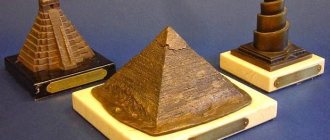This form of buildings is found on all continents and has existed at all times, and it still attracts a lot of tourists.
But not only travelers are interested in the mysterious form - the Taoists also attached no less importance to it: according to Feng Shui, the pyramid with an eye has the most powerful meaning. The symbol of Freemasonry, the radiant delta, which represents an all-seeing eye drawn in a triangle, has now gained unprecedented popularity.
Pyramid: feng shui meaning
According to Feng Shui, the pyramid has a very strong meaning; it is considered a powerful amulet, and also a fulfiller of human desires. It is enough to simply write your cherished desire on a piece of paper, fold it and put it under the pyramid - and it will certainly come true.
Throughout the centuries, pyramids have attracted people with their mystery and mysticism. Scientists note that famous buildings have such a shape for a reason: the pyramidal shape is capable of capturing energy at its tip, as if concentrating it at a single point, at its peak, and then as if collecting and accumulating it inside, between its edges.
Many travelers who visited the pyramids in distant lands noted that after this they began to feel much better physically, and their minds seemed to clear up.
After the healing and positive properties of the pyramids were revealed to humanity, miniature projections of them began to be created from stone, glass and crystals to be used as a talisman. Surprisingly, such a miniature pyramid can not only improve the energetic atmosphere in the home, but also relieve some diseases, illnesses and adversities.
A pyramid placed in the right place in an apartment can increase productivity, relieve melancholy or apathy, stimulate career and spiritual growth, and give strength. Just as the tip of a pyramid helps to capture the energy flow, collecting it between the internal edges, so a miniature projection of a pyramid can become a powerful source of a positive energy field.
A correct feng shui pyramid should be heavy, weighty, and definitely solid. Hollow pyramids do not have the ability to accumulate and concentrate energy, and therefore they are useless. Also pay attention to the edges of the pyramid - they should be perfectly smooth and polished, and its top (the peak of the pyramid, or its tip) should not be knocked down, sharp.
The “golden ratio rule” also plays an important role here. A high-quality feng shui pyramid follows this geometric law.
The pyramid is able to neutralize any negative energy or negative vibrations; it brings the necessary balance and balance into a person’s home, thereby even improving overall physical well-being. That is why the pyramids are famous as figures capable of healing.
European military pyramids
Pyramid of Austerlitz. 2008 © Bart Koop-Henzen / Flickr
Since the middle of the 18th century, in the projects of many European architects, the pyramid takes on a new meaning - a military monument. One of the most famous military pyramids in Europe stands in the Dutch town of Austerlitz near Utrecht. The Dutch Austerlitz was founded in 1806 after the Battle of Austerlitz in the Czech Republic in December 1805 and was named after it. Next to it was the vast field of Zeist, where at that time At that time, the Napoleonic troops that occupied the Netherlands were stationed - they built the pyramid. French soldiers erected it in September - October 1804 on the orders of commander Auguste de Marmont, who participated in Napoleonic's Egyptian campaign of 1798-1801 and saw Egyptian prototypes.
The pyramid was built to honor the victories of the French army, which blessed the Zeist field with its presence, and also to occupy idle soldiers. The shape is the most practical: an earthen hill 36 meters high with a wooden obelisk on top. Marmon bought the land on which the pyramid stood with personal funds. At first, the hill was called the Pyramid of Marmont, but after the victory at Austerlitz, the new Dutch king Louis Bonaparte, Napoleon's brother, renamed it the Pyramid of Austerlitz, which caused Marmont's public discontent. Initially, Marmont planned to cover the pyramid with stone and install a huge statue on it, cast from the cannons that he planned to capture in future battles. But after Napoleon's final defeat at Waterloo in 1815, he sold the pyramid.
What color and what material should I buy a feng shui pyramid from?
Feng Shui pyramids are made from a wide variety of materials, but those made of crystals or natural stone are most valued.
- You should know that transparent glass pyramids have a positive effect on career and finance. Pyramids of pink or lilac shades are responsible for the sphere of love and relationships.
- Pyramids of shades of the element of Water (blue and cyan) control the human mind, improve thought processes, and increase intelligence.
- But the green hue of the pyramids helps you improve your skills and derive material benefits from them.
The notorious pyramid with an eye is a powerful amulet against all earthly troubles and misfortunes; it sharpens the intellect, helps to reach unprecedented heights, and achieve your goals. Its symbol is interpreted as a sign of the Great Architect - a being who created all things and endowed the earth with secret knowledge. The power of this pyramid is great and should be handled with care. It is not recommended to place the pyramid in the sleeping area, in close proximity to the bed.
First, it would be a good idea to decide for what purpose you needed the pyramid in order to choose the optimal solution. For careerists, it is best to choose a transparent pyramid of bluish shades; for those thirsting for love, it is best to choose a pyramid of stones in a purple-pink color palette.
It is better that your Feng Shui pyramid is made of natural material. For example, made of stone. But such pyramids also cost an order of magnitude higher, because even a small pyramid requires quite a lot of material. Pyramids made of crystals are somewhat cheaper, and miniatures made of glass are the most affordable. The classic transparent and colorless pyramid made of ordinary glass is very popular in offices and on desktops, because it helps to concentrate on business and climb the career ladder faster.
According to Feng Shui, an onyx pyramid is a very strong amulet, because onyx itself has powerful properties, and when concentrated in the faces of the pyramid, they become even more powerful. Such a pyramid will cost a lot, but it will also bring a much more noticeable charge of energy into the house than an ordinary glass pyramid.
Pyramids-temples of the Russian Empire
Temple-monument to the soldiers who fell during the capture of Kazan in 1552. Postcard from the early 20th century © Wikimedia Commons
The Kazan monument combines the tradition of the pyramid as a war monument with the function of a temple. The temple dedicated to the Savior Not Made by Hands was built in 1813–1823 according to the design of St. Petersburg architect Nikolai Alferov over the mass grave of Russian soldiers who died during the capture of the city in 1552. The pyramid is decorated on all sides with Egyptian porticoes, three of which serve as the entrance to the temple.
View of the St. Nicholas Church-monument, erected in honor of the fallen soldiers who defended Sevastopol in 1854–1855. Photo from the album “Crimea. Cities and localities of the Tauride province" © humus/LiveJournal
The pyramidal St. Nicholas Church rises on a hill at the Brotherly Cemetery of Sevastopol. It continues the tradition of the Kazan Church and is dedicated to the memory of those who fell during the Crimean War of 1853–1856. It was built in 1857–1870 according to the design of the Moscow artist, archaeologist and architect Alexei Avdeev, who lived in Crimea. The theme of Egypt is used here only as a general image of eternity: a Byzantine temple decorated with mosaics is hidden inside the pyramid.
Feng Shui pyramid: where to place it?
After you have made your choice and decided what color and what material to purchase the pyramid from, you should familiarize yourself with the nuances of its placement in the living space. There are special sectors, or, more simply put, directions of parts of the world in which certain properties of the pyramid are most clearly manifested.
By controlling and redirecting the flow of Qi energy, a pyramid installed in the desired area of your home can provide truly strong support and assistance, and it would be extremely stupid to neglect this. Select the area in the house you need to adjust your life, and then boldly place a pyramid in the center of this sector.
| Direction | Sphere of influence of the pyramid |
| Southwest | Love sector. An ideal place to place a pyramid to bring back the passion and ardent feelings of spouses and improve relationships. |
| West | Harmony and balance in relationships with the world, increased communication skills, the ability to protect your children and household members. |
| East | Family and health sector. It will help improve family relationships, improve physical health, protect and preserve the family hearth. |
| South Southeast | Responsible for financial well-being. The south is the sector of fame, helps to achieve great heights, achieve success in your career, and brings prosperity. |
| North | Increases efficiency, positively affects career, improves financial well-being, stimulates the growth of material well-being. |
It is important to remember that the range of action of a miniature pyramid is not infinite. Thus, an ordinary pyramid made of glass or crystals has the greatest power within 0.5-1.5 meters around its axis. Pyramids made of stone, as well as those with additional symbols, are somewhat more powerful - for example, according to Feng Shui, a pyramid with an eye has a radius of at least three meters.
Symbolism and purpose of the Egyptian pyramids
It is impossible to give any single explanation for the pyramids, since their shape arises in a very complex context of funerary rites. In reality, the pyramids were tombs symbolizing the idea of eternity.
The first conclusion about the symbolic meaning of the pyramids was developed in the 19th century. the outstanding Egyptologist Ernesto Schiaparelli (1856-1928). In contrast to positivist theories, which emphasized exclusively the highest point of the technical process, according to Schiaparelli, the pyramid symbolized the vital energy of the Sun, which was transmitted to the pharaoh in his tomb. All four sides of the pyramid face exactly the direction of all four cardinal points, which was also interpreted as a symbolic connection with the number four, which was endowed with divine and cosmic characteristics.
The square foundation on which the pyramid rises was supposed to express the relationship between the pyramid and the cosmos, and therefore between earthly life and divine life. On the other hand, the purpose of the pyramids can only be understood in the context of the religious character that permeated the life of the Egyptians. The collective efforts required for its construction illustrate the discipline and organization of the entire people.
As for the purpose and symbolism of the pyramids, the words of Egyptologist James Henry Bristide (1865-1935) are indicative and typical, who wrote about the Great Pyramid: “Probably there were not many stonemasons or just people who would have mastered the technique of building with stone in those days , when Khufu-onek made his first walks across the desert plateau, plotting the fundamental plan for the construction of the Great Pyramid. Thus, we can understand the fearless energy of the man who ordered to mark out a square base with a side of 230 m. He knew what he needed 2,5
million blocks of
2.5
tons each, to cover this square of 53 hectares with a pyramidal mountain 147 m high. The Great Pyramid of Giza therefore represents a document from the history of the human mind. Together with it, the human meaning of sovereign power is clearly manifested. The engineer managed to immortalize himself and his pharaoh thanks to his perfect mastery of material forces." (74)
Pyramids at Gize
The complex of the largest pyramids in Giza was built by the pharaohs Cheops, Khafre and Menkaura during the IV dynasty. These pyramids represent only the most conspicuous part of the entire mortuary complex, which includes two temples (one, the mortuary temple, located in the eastern part of the pyramid, the second, the valley temple, on the river bank), connected by a corridor, and a walled room.
The construction of these different buildings corresponded to the phases through which the ashes of the pharaoh had to pass before being finally placed in their funerary crypt. The ritual route of the deceased began at the valley temple, where the corpse was mummified. From there he was transferred to the mortuary temple, where ceremonies were performed that were supposed to give him immortality. The path from the lower zone of the river valley to the highest part of the desert, where the pyramids were located, was marked by an ascending path, which gave symbolic meaning to the route of the procession of the deceased pharaoh.
The Pyramid of Cheops (Khufu) is the ultimate "pyramid" of Egypt, the most monumental of the three. This is probably the architectural form that has received the most expression in literature since it became known to the Western world.
It is built on a square foundation with a side equal to 230 m and reaches a height of 147 m. The direction of each side corresponds to the cardinal directions. Inside the pyramid there are three burial chambers, which turned out to be different as a result of various modifications made during their construction. The entrance to the first of them is on the north side of the pyramid and leads into a corridor that goes sharply down to the room itself. This room is located on the most vertical axis of the pyramid. You can enter the second room through the previous corridor, which deviates upward along its length and then runs parallel to the base. Here the room has a false vault. The last, third room is located on a level rising above the other two. The entrance to it comes from the narrow corridor of the second room, and is preceded by an entrance hall protected by three granite slabs. The burial crypt has a roof protected by five loading rooms and a gable roof. Currently ongoing engineering studies have shown the high accuracy with which the static forces of the pyramid's mass are distributed. It is surprising that the Egyptians could intuitively achieve such a uniform distribution of forces in its construction, distributing them along various points of the stone mass, as a result of which they were absorbed by the gravity of the earth.
There is a generally accepted opinion that the pyramids (75) were built using parallel slopes on each side along which the building materials were raised. These slopes, made of mud and gravel, were of a length depending on the needs of the construction and were removed upon completion to maintain a clean architectural form.
During the Fifth Dynasty, other pyramids were built at Abusir and Saqqara, similar to the pyramids at Giza and with the same layout of the funerary complex, but of brick material and much smaller dimensions.
Also during the Middle Kingdom, during the XII Dynasty, pyramids were built of brick, covered with slabs of limestone, of which barely visible traces remain today. These were more symbolic than monumental buildings, a continuation of the tradition of their ancestors, which was preserved, perhaps, out of fear of consigning the ancient custom to oblivion. Later, between 750 and 350 BC, Ethiopian kings built over 180 pyramids in Nubia. These are buildings that are arranged in the same way as huts are distributed in an African village. The greatness of Gize was lost forever, and tombs like those of the Old Kingdom were never built again. (76)
History of art. The first civilizations. – Per.
from Spanish – JSC “Beta-Service”, 1998. P. 59-87.
Egyptian architecture was distinguished by its desire for geometricism and linearity, for the deployment of compositional elements along a single axis, and for symmetry. It is characterized by large wall surfaces, slightly sloping on the façade side and ending in curved cornices.
The despotic form of power, brought to the absolute and closely associated with religion, led to the foreground in the monumental construction of religious buildings, which were erected from stone capable of preserving the remains of the pharaohs and the memory of them for many centuries. Other structures were built from less durable materials.
However, at an early stage of development, within the predynastic period, due to the insufficient development of productive forces, even religious and defensive-fortress structures were built from raw brick, broken earth and wood for ceilings. The beginning of the replacement of these materials with stone dates back to the III Dynasty of the Old Kingdom. The first construction of this time, carried out not using the adobe method, but through the use of roughly chopped stone, was the tombstone of Pharaoh Djoser. Its main part - the pyramid - consists of five truncated volumes, placed on top of each other and gradually decreasing towards the top. (12)
The shape of a truncated pyramid was widely used in early times in structures for the burial of representatives of the nobility. Such tombs are called mastaba (Arabic for bench). The Pyramid of Djoser represents a composition formed by, as it were, five similar mastabas placed on top of each other. The pyramid of Djoser, like the later pyramids, had no internal volumes, with the exception of the funeral chamber, the entrance to which was walled up and carefully hidden.
Further development of the form of the burial pyramid took place during the reign of the pharaohs of the III and IV dynasties along the line of reducing the number of volumes included in the composition. The pyramid in Medum no longer consists of five, but of three volumes, and the pyramid of Dashur - of two: on the lower part - a truncated pyramid - a second link is installed - not a truncated, but a full pyramid with a pointed apex. This structure is already transitional to the finished type of Egyptian pyramid, formed by four faces. The most perfect examples of such tombstone pyramids date back to the IV dynasty. As a result, the period of the reign of the pharaohs of the IV dynasty is called the “era of the great pyramid builders.”
The main complex of pyramids of the Old Kingdom of the IV Dynasty is located in close proximity to the city of Cairo, on the left, western bank of the Nile near the village of Giza. Hence the name —
an ensemble of Gizeh pyramids, formed by three pyramids, the tallest in Egypt - Cheops, Khafre and Mikerin.
The most significant and famous of them is the Pyramid of Cheops (height 146.6 m) (ill. 3). This is a grandiose structure, one of the largest ever created by mankind, on which a hundred thousandth army of slaves worked for 20 years. The pyramid was made of stone blocks, in the outer layers -
a regular prismatic shape, currently forming from the outside the semblance of a grandiose stepped staircase (the size of the blocks reaches 1.5 - 2 meters). Initially, the pyramid had perfectly smooth surfaces on all four of its faces, since a triangular prismatic block of white Mokatama limestone was laid on each of the “steps”.
From the hidden entrance, walled up, as in all Egyptian pyramids, there was an inclined ascending gallery-corridor, which in the central part of the thickness of the pyramid led to a small vestibule chamber, next to which there was a funeral chamber, measuring 5x5x10 meters, with a sarcophagus. Its walls were formed by huge blocks of granite, and the ceiling was a multi-layer “unloading” system of stone monoliths alternating with voids.
It is possible to trace the connection between the Egyptian pyramids and the structures of primitive society: the burial chamber of the pyramid is to some extent similar to the internal volume of a megalithic dolmen.
The neighboring pyramid, slightly inferior in height to the one named, was built by Pharaoh Khafre...
The era of the great pyramid builders was the time of maximum consolidation of the despotic monarchy of Egypt. The pharaoh, who stood at the top of the hierarchical class ladder, concentrated in his person the fullness of secular and spiritual power. Hence the desire to capture his personality by material and ideological means, to create a monument of unsurpassed size during the life of the pharaoh as a symbol of his power, might and as a repository for his mummy. The entire system of constructing the mortuary complex, including the pyramids, was dedicated to this goal.
During subsequent dynasties, the size of the pyramids decreased due to the weakening of the economic basis of the state and the political power of the pharaohs. (14)
Bartenev I.A., Batazhkova V.N. Essays on history
architectural styles: Textbook. allowance. M.: Image.
Art, 1983. 384 pp., ill. pp. 12-14.
Funerary temples
Funerary structures, which were created for the purpose of carrying out the rituals preceding the final placement of the deceased in the tomb, were clearly defined already during the IV Dynasty, starting with the construction of the pyramid at Meidum. Both architectural modules that complement the tomb are temples, one located in the valley and the other on the eastern side of the pyramid, connected by an ascending paved road. In the temple of the valley, the process of mummification and purification of the ashes was carried out, and in the funerary temple of the pyramid, the ritual ended with the most important ceremony - the “opening of the mouth”, through which
the deceased was brought to life by the statue.
In the mortuary complex at Giza, the Valley Temple at the Pyramid of Khafre is the only temple from which significant architectural remains remain. It consists of a square foundation and slanted smooth walls. The entrance on the east side of the building has two symmetrical passages with separate vestibules that connect in the hallway. The hallway leads to an inverted T-shaped hypostyle hall consisting of a longitudinal storehouse with two rows of columns, the interior walls of which were lined with 23 seated statues of Khafre. During the construction of the hypostyle hall, for the first time, a tetrahedral pilaster was used as a support, serving as a free support without a supporting wall. A wise combination of elements and a sense of proportion ensure that the pink granite stone blocks give uniformity to the entire building. Light penetrated through slits made in the flat roof. The building, which is symbolic, has architrave architecture. In addition, the hypostyle hall has perfect harmony.
Of the mortuary temples of the Giza complex, only the Pyramid of Menkaure contains such remains that make it possible to reconstruct the original. In the Temple of Cheops, the oldest, there are remains of square basalt columns that surround the courtyard, indicating the type of construction characteristic of temples dedicated to the gods. However, it is the temple of Menkaure that contains information about the presence of a large courtyard, open to daylight and surrounded by columns. (76)
History of art. The first civilizations. – Per.
from Spanish – JSC “Beta-Service”, 1998. P. 76.
The neighboring pyramid, slightly inferior in height to the one named, was built by Pharaoh Khafre. Its temple complex has been partially preserved. On the banks of the Nile, not far from the pyramid, a lower mortuary temple was built, usually called the “temple of the Sphinx,” since nearby there is a huge rock-cut image of the Sphinx, a character in Egyptian mythology with the body of a lion and the head of a man (sometimes with the head of a ram), personifying strength. and the power of Pharaoh Khafre. (13)
The lower mortuary temple was a rectangular structure containing a T-shaped hypostyle hall inside (this was the name given to halls in the architecture of the Ancient World, the space of which was divided by separate supports into parallel galleries-naves). The beam floor was supported by rows of rectangular supports - monolithic pylons (Fig. 2). Extended girder beams rested on them, and on them, in the perpendicular direction, so-called secondary beams such as solid slabs were laid, which actually formed the ceiling. The lower mortuary temple at the pyramid of Khafre is the first of the structures that have come down to us, where the post-beam system described here was used in its finished form. Logical and extremely simple, it has found wide application throughout world architecture, right up to our present day.
Let us note that there is an obvious continuity of the constructive solution of megalithic structures and the post-beam system that developed in the initial stage of development of the architecture of Ancient Egypt (compare illustrations 1 and 2).
From the lower mortuary temple there was a long closed corridor - the dromos, which reached the upper mortuary temple, directly adjacent to the pyramid, but completely isolated from it. This mortuary temple included three elements: a hypostyle hall for ordinary, unnamed people, a peristyle courtyard (that is, a courtyard surrounded by free-standing supports) for the Egyptian nobility, and, finally, a sekos - a sanctuary intended for priests. This system of building a temple will be transferred to other structures of this type.
...In the peristyle courtyards of mortuary temples at the pyramids of the 5th dynasty, there are round supports - columns, in this case of a palm-shaped type with an upper part - a capital in the form of a closed crown of a palm tree. Elements of figurativeness pervade Egyptian architecture widely; Along with palm-shaped columns, lotus-shaped and papyrus-shaped ones appear (see below). (14)
Bartenev I.A., Batazhkova V.N. Essays on history
architectural styles: Textbook. allowance. M.: Image.
Art, 1983. 384 pp., ill. pp. 13-14.
Crypts
Beginning in the Middle Kingdom, the lack of level ground in the vicinity of the new capital of Thebes encouraged the development of a new type of funerary structure: crypts, chambers carved into the rocky slopes that surround the banks of the Nile.
The crypts continued a tradition that began in the Old Kingdom of building tombs by hollowing out stone walls. The approval of the crypt model as a funerary architectural complex presupposes its connection to the landscape in which it is placed. Unlike the Old Kingdom, where the size of the pyramids contrasted with the horizontality of vast expanses of sand, crypts are not a structure imposed on the horizon, but a binding of the resulting volumes to the space available in the surrounding area.
The internal structure of the crypts largely preserves the structure of the royal tombs of the Old Kingdom, that is, it extends deep into the mountain. (76)
Previous8Next
Recommended pages:










